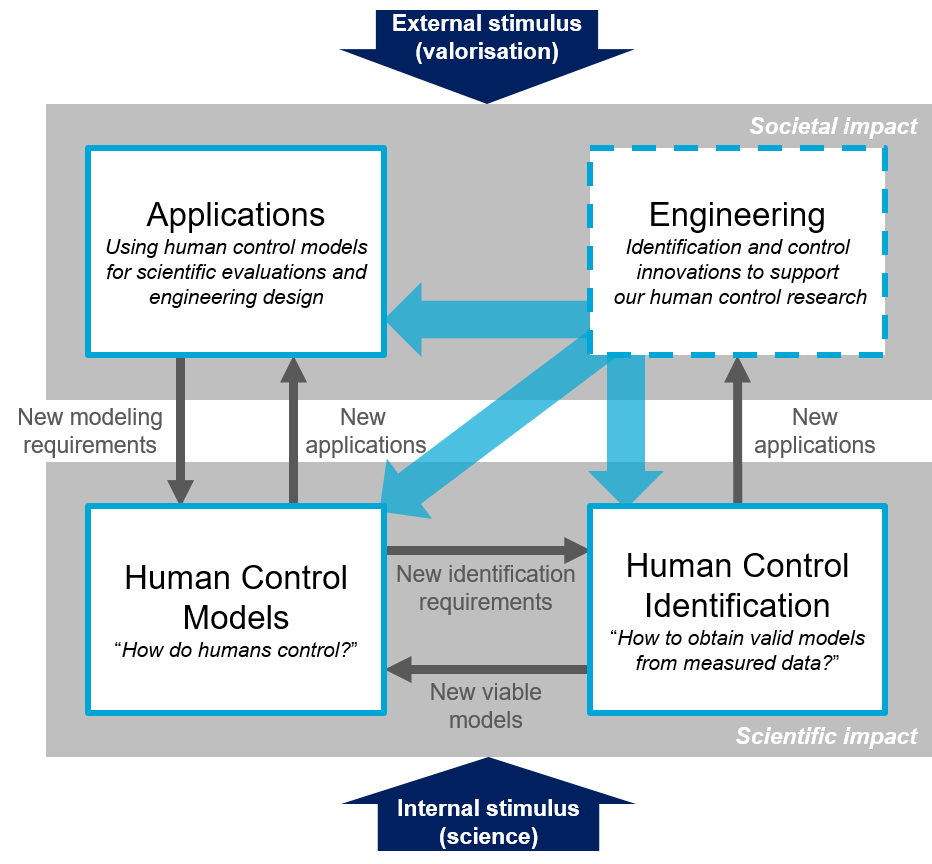About our Research
Enhanced understanding and support for humans in control through a model-based “cybernetic” approach.
Fueled by our own scientific curiosity as well as external stimuli and questions from industry, it is our ambition to develop the required understanding of how humans perform manual control, to capture the key essence of human control in mathematical models, and apply this knowledge for engineering applications in the real world. It is our sincere belief that only through fundamental advances in our knowledge of human control and quantitative modelling techniques to describe it, we can be successful in adequately supporting the human factor in aerospace.
Our research is very experimental in nature, as it is our firm belief that structured analysis of human control behavior requires carefully designed experiments. For our many experiments, we make use of the research facilities available at the Control & Simulation section of TU Delft’s Faculty of Aerospace Engineering, such as the SIMONA Research Simulator and the PH-LAB laboratory aircraft.
As shown in the graphical overview below, our research activities fall into four main focus areas:
- Human control models: fundamental research on understanding and modelling of human control behaviour
- Human control identification: fundamental research on system identification and mathematical modelling methods for human control behavior
- Applications: applied research where we use our quantitative models of human behaviour for scientific evaluations and engineering design
- Engineering: applied engineering research to improve real-world systems in support of our research
Human Control Models
In this focus area of our research, we develop novel computational models of human behaviour, covering characteristics of human manual control that are as of yet little understood. From measured human-in-the-loop data, collected in dedicated experiments performed in our simulator facilities at Aerospace Engineering (SIMONA, HMILab) or even our laboratory aircraft. We work on understanding and modelling how humans use specific key information that is available from visual displays, the view from the cockpit windows, or the physical sensation of movement, for their manual control. How this information is processed, weighed, and combined with other information, and where human limitations (e.g., response delay, neuromuscular limitations) affect control performance.
The main successes achieved in the last years are the models of how human pilots use motion feedback for control, human information of preview information, and the feedforward control responses human adopt in many tasks.
Find specific projects hereHuman Control Identification
The fact that humans are inherently inconstant, highly adaptable, and very “noisy” systems makes the development of proven, accurate system identification techniques a fundamental challenge. Also, this severely limits the perturbations/excitation that can be applied when collecting data of humans in control: basically the definition of the task for which human control is identified. Therefore, the research in this branch focuses on both the development and testing of new system identification and modelling techniques, but also on the design of optimal “forcing functions” for manual control identification.
Examples of recent innovations in human control identification include the development of customized model selection criteria for multi-channel human control identification, as well as the development of techniques to detect and model time-varying adaptations of human control.
Find specific projects hereApplications
We also actively work on applications of our fundamental advances in modelling and identification of human control behaviour, both in the field of aerospace engineering, and beyond. We roughly distinguish two types of applications of our work:
- “evaluations”: quantitative comparisons of human control behaviour to determine optimal working conditions (e.g., motion cueing fidelity)
- “synthesis”: human control model implementations in design applications (e.g., shared control and touchscreens).
Highlighted aerospace applications of our human control research are the objective and quantitative evaluation of simulator motion fidelity , the explicit tracking of pilots’ control skills during simulator-based training, and the measurement of pilots’ sensitivity to motion disturbances during touchscreen operation on the flightdeck. Outside the aerospace domain, together with our collaborators, we also apply our methods to the detection of degraded motor skills in Parkinson’s disease and individualized shared control systems for car driving.
Find specific projects hereEngineering
While not a main focus area, our group also works on advances in system identification, mathematical modelling, and control techniques to other applications than human manual control. This work directly feeds back into our manual control research, as we aim at advances in simulator and simulation technology that will support enhanced human-machine systems and future human-in-the-loop experiments.
Examples of our engineering work include state reconstruction and sensor fusion for moving-base flight simulators, model-based and model-free control of simulator motion systems, and aerodynamic stall model identification from flight test data.
Find specific projects here


